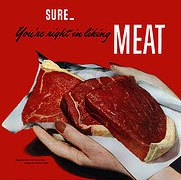Why 'Antibiotic-Free' Meat Doesn't Mean What You Think It Does

(SA_Steve)
Antibiotic-resistant infections are a serious and scary threat to public health. One reason why devious bacteria are evolving to resist antibiotics is the widespread overuse of them in both humans and in animals. A Center for Science in the Public Interest analysis of Food and Drug Administration data shows that 80% of all antibiotics administered are to animals, and not to help them get better when they’re ill. Meat and dairy producers give low doses to the critters in their care in order to prevent illness, and sometimes to promote faster growth.
“Ew,” you might say. “How can I avoid meat produced with low doses of antibiotics?” Food producers know that consumers are aware of this problem and want to avoid drug-laden food, so some use confusing labels that don’t quite mean what they say. Here’s an easy summary of which labels to look for and which to avoid from our sibling publication, ShopSmart.
Labels to look for
– Organic
– No antibiotics used (or similar)
– American Grassfed Food Alliance
– Certified Grassfed
Confusing labels
– Natural
– Antibiotic-free
– No antibiotic residues
– No antibiotic growth promotants
Those are the quick notes to keep in mind for shopping. For more detail, check out the full “Meat on Drugs” report from Consumer Reports, which details the findings when our parent company sent an army of secret shoppers out to their neighborhood grocery stores to see what meat produced without antibiotics they could find, and how truthful the labels really were.
Meat Without Drugs [Official Site]
RELATED:
Study: 25% Of Meat Sold In Groceries Contains Drug-Resistant Bacteria
FDA Bans “Extra-Label” Uses Of Popular Class Of Antibiotics On Farm Animals
Want more consumer news? Visit our parent organization, Consumer Reports, for the latest on scams, recalls, and other consumer issues.

